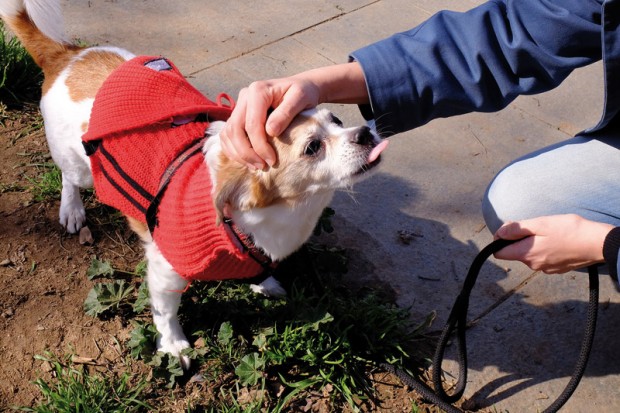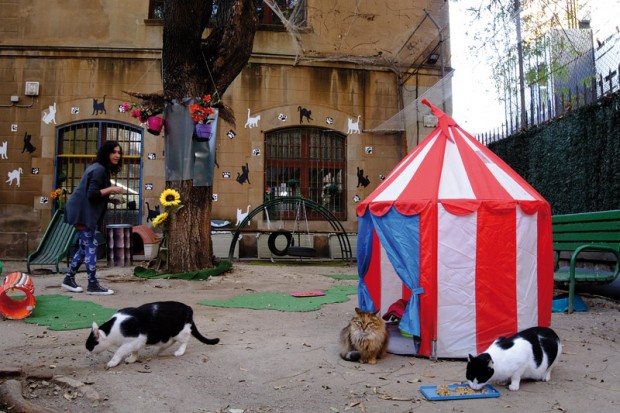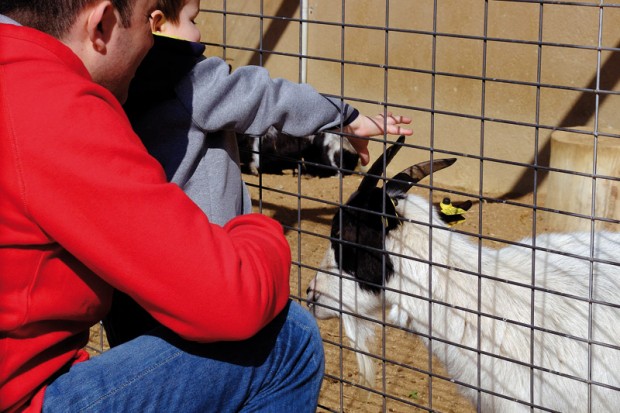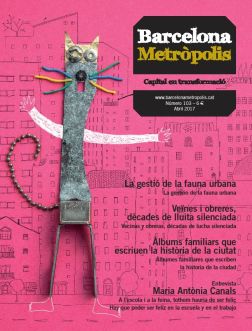Almost half of Spanish homes have a pet, usually a cat or dog. We need to know how to prevent relationships that may have negative consequences and promote those that are beneficial to both humans and animals.

Districts with the highest density of pets – mostly cats and dogs, like the one in the photo – report lower crime rates and better health statistics. Interaction with animals improves people’s social skills and children’s development.
Photo: Vicente Zambrano
Anthrozoology is the science that studies the interactions and the bond between humans and other animals. Even though this science is less than forty years old, interactions with animals have been part of human life since the very beginning, as is shown by ancient cave paintings, which mainly depict animals.
Non-human animals currently take part in the daily dynamics of cities. The animals with which we have a higher degree of integration and bonding are our pets, mostly cats and dogs. In fact, 49% of Spanish households have a pet. We need to know the whole spectrum of relationships that we build with our pets, so we can avoid those that have harmful consequences and promote those that are beneficial for both humans and animals.
One of the main purposes of anthrozoology is to study the pathological relations that we have with animals, including what is known as Noah Syndrome or the hoarding of animals. This mental health condition has been internationally recognised since 2013. Sufferers accumulate a large number of animals that they cannot properly take care of and they do not recognise the poor conditions that their animals experience. This condition has serious implications for the welfare of the person and the animals and can also cause public health issues. The animals usually have parasites, injuries and a range of diseases. It is a real challenge to care for so many animals in such poor health. Anthrozoologists are working to draw up procedures for effective early detection and actions to deal with this syndrome.
Cruelty and abandonment
Anthrozoology also looks at the area of cruelty to animals. Each year in Barcelona, there are dozens of reported case of animal abuse. Most developed societies have legal proceedings to put a stop to animal cruelty and in Catalonia we also have an animal protection law. It is not just about fining people who harm animals but also about promoting active prevention, and the best way to do this is by educating the public from childhood about respecting animals.
Another negative aspect of human-animal interaction is abandonment. In Catalonia, more than twenty thousand abandoned animals are picked up every year. Even with the rise in rehoming, we never manage to rehome all the animals that are abandoned. Cat and dog rescue centres provide them with good living conditions, but the best environment for their welfare is a family home. The main cause of abandonment is unwanted litters and this is why large-scale sterilisation of domestic cats and dogs is promoted. When an animal is abandoned, it signals a lack of awareness of the responsibilities of pet ownership; we often bring an animal into the family without thinking of the long-term commitment that it entails. So we need to find the most effective methods to educate the public about responsible behaviour.
Cat colonies
When we talk about homeless animals in the city, we must also talk about the street cats or feral cats that roam the streets in urban cat colonies. We are used to their presence, even though they cause controversy and they annoy some people. On the one hand, feral cats negatively affect our native vegetation but on the other, urban cat colonies have proven to be very useful when it comes to pest control, especially of rats and mice, so we need them to maintain the balance in the city’s ecosystem. However, they do need to be in an ethical control programme, such as the one we have here in Barcelona. This programme involves feeding the cats appropriately in order to prevent hygiene issues, sterilising them to prevent uncontrolled reproduction and monitoring their health.

The Jardinet dels Gats, a colony of feral cats managed by an organisation with the same name, in a garden opposite the Romea Theatre in El Raval. Several animal rights organisations look after cat colonies in Barcelona and other municipalities, with support from the respective local councils.
Photo: Vicente Zambrano
There is a mistaken belief that the life of a street cat is a cat’s ideal: on the contrary, their life expectancy is much shorter than that of a domestic cat. And it is often thought that any cat can live happily on the streets, but cats that are used to a home life find it very tough to live out in the ‘wild’. We need to fight against people abandoning their cat on the street, thinking that it will have a good life. Once again, it proves the need to raise awareness of responsible ownership.
A source of social capital
The presence of pets in our environment has proven to be a source of social capital, in other words, something that lets people bond with each other in advantageous and positive ways, with a sense of community. A city that has high levels of social capital has civic-minded and collaborative citizens. Several different studies have shown that neighbourhoods with a high density of pets have lower crime rates and that their residents have better health indicators. Within a neighbourhood, pets encourage social interaction and bring certain advantages, although they also lead to some conflicts. That is why we need rules to regulate and help with the movement and care of pets because responsible ownership develops social capital and prevents conflicts of interest.
Recent studies by the Chair of the Affinity Foundation Animals and Health have highlighted that many cat and dog owners in Spain have an emotional bond with their animals and even see them as another member of the family. This bond appears to be universal across cultures. The positive effects of sharing one’s life with a pet fall into two groups: physical and psychosocial. On a physical level, contact with a pet lowers blood pressure, for example. When it comes to the psychological and social benefits, science has proven that animals are social catalysts, in other words, they help us to socialise with other people. The fact that the animal is part of our social network helps us to overcome stress. Contact with animals lessens fear and anxiety, the symptoms of depression and levels of aggression, and it also encourages communication, positive moods, and positive social behaviour toward other people.
Healthy childhood development
There is much to be gained from living with an animal, especially for children. It has been demonstrated that contact with pets is good for a child’s healthy development. The emotional support that a child gets from a relationship with an animal has been widely researched. Numerous studies in many different countries show that children who are going through a difficult time, emotionally, seek comfort in animals. The relationship between children and animals also helps children to develop empathy and positive social behaviour. Children that have close ties with animals are generally more empathic. Additionally, incorporating animals into children’s’ lives appears to help their cognitive and language development. Lastly, the development of the immune system is another benefit of living with animals. Children who have pets are less prone to allergies and have lower rates of school absenteeism, and we can infer from this that having animals around strengthens a child’s immune system.

Interaction with pets and domesticated animals has many therapeutic benefits and promotes people’s sociability. In the photo above, a family visit the farm at the Can Cadena Urban Garden Farm (HUM) local education centre, in Sant Martí park.
Photo: Vicente Zambrano
We can go even further, by applying the benefits of human-animal interaction in a focused and therapeutic way, through animal-assisted interventions (AAI). AAIs are used for all kinds of groups: people with mental health conditions or physical disabilities, socially marginalised people and other people with special needs. The actual effects of AAIs, which are widely used in this country, are currently being studied to assess their benefits.
Interaction with the pets around us in inevitable. And we need in-depth knowledge of its consequences and effects, both positive and negative, in order to build the best possible harmonious relationship between human beings and the animals that make such an invaluable contribution to society.




Felicidades por el artículo!
Em sembla un article fantastic
Estupendo artículo! Felicidades!